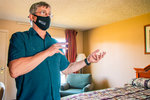
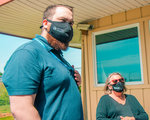

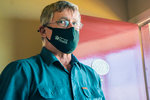

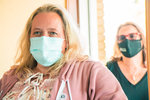
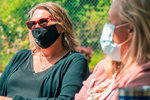
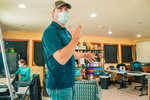


Karen Pastori, a Napavine resident of 16 years, says she loves her community.
But sometimes, rumors spread. Often, like a bad game of telephone, the word isn’t always accurate.
So when Pastori started hearing unsubstantiated rumors in the community regarding the new state-coordinated isolation and quarantine facility that opened last week at the Lakeview Inn in Centralia, she knew something was off.
She knew because she works there as a strike team lead with the Washington Department of Health.
“It’s not all the horror that people are portraying (it as) in the county,” Pastori said.
But that hasn’t stopped some curious community members from stopping by the facility. On at least one occasion, staff had to ask a person who was in opposition to the facility to leave and respect the privacy of those inside recovering.
The new isolation and quarantine facility, located at 1325 Lakeshore Drive, has become a lightning rod attracting folks who flat out oppose it and those with good-faith concerns about the safety of their community. But staff members — some of whom live just miles away — say they have faith in the safety systems the state has developed.
“This is my community as well, and I would never want to bring harm to my community,” said Jessica Stevens, an isolation and quarantine facility operations support staff member. “When people pass, I just smile and wave.”
Staff at The Chronicle got the chance to tour the site this week to learn more about the inner workings of the facility, how staff members work to ensure safe recovery periods for those infected with COVID-19, and why Lakeview Inn largely fits the desired criteria to host such a site.
From Thurston to Lewis County
The Department of Health’s isolation and quarantine facility, which was established following the start of the pandemic, is the only facility of its kind in the state and broadly serves as a “catch all” host for those who don’t fall under the jurisdiction of county-run isolation and quarantine facilities, said Ben Schenk, isolation and quarantine facilities task force leader.
Its patients include shipping and vessel crews, travelers who contract the virus and work release inmates. The facility does not serve homeless individuals, per a contract stipulation from the inn’s owners.
On Thursday, about a week into the Department of Health’s occupation at the site, there were only four people receiving care. All were in the “isolation” phase of their stay, which means they were recently infected and in the process of “getting over” their contagion, staff said.
Of the four patients, two were work release inmates, one was a female who likely contracted the virus while traveling through the state and one was a military service member set to deploy before testing positive for the virus.
The second floor at Lakeview plays host to a “quarantine wing” where people who have been exposed to the virus stay.
Staff members said it is important to underscore the fact that the process is all voluntary and that many patients have been thankful to have a place to go — especially if they’re far from home — to get over their virus.
“Having a facility like this is nice. You want to make them feel as comfortable as possible,” said Wayne Clifford, medical surge branch director with the Department of Health, while standing in a room overlooking Plummer Lake.
Rooms haven’t been altered much, if at all, to accommodate patients. A pair of trailers are parked just outside the first floor rooms, and a chain link gate surrounds the perimeter of the inn’s property with the phrase “NO VACANCY” printed on a large sign near the entrance. Certain rooms on the first floor were also taped off with a sign reading “Mandatory PPE N95 Mask.”
The inn’s front office saw the largest change. Foldable tables were erected and shelves were stocked with chips, canned goods and ramen noodles. Nearby freezers also held microwaveable meals for patients.
“This entire place had to be wiped down, cleaned, top to bottom,” Stevens said of the front office, which also serves as the staff area.
Staff schedules and a calendar showing each patient's timeline are hung up. Staff provide around-the-clock services.
As patients are checked into isolation, Schenk said they’re given a four-day box of food that includes microwaveable meals, fresh produce and special-ordered food items from nearby grocery stores.
“If it’s practical, and we can get it from the grocery store, we are more than happy to get it for them,” Schenk said, noting that they usually make the trip about twice weekly.
Patients’ vitals — including their temperature, blood-oxygen levels and blood pressure — are also checked twice a day while in isolation.
More than 160 patients have utilized the Department of Health’s isolation and quarantine facility — previously located in Thurston County — since the beginning of the program, Clifford said. Staff members are used for patient transportation, and that includes the rare trip to the hospital in cases where their condition worsens, which has only happened a few times.
A plus with the state’s site is also that it is largely scaleable, especially in cases where a shipping crew becomes infected. That happened recently.
“This thing can go from zero to 20 or 30 people in a matter of a day or two,” Clifford said.
The facility it being funded through a state reimbursement program with the Federal Emergency Management Agency.
Community Response to the Facility
Hospital proximity, proper architecture — including non-enclosed walkways and rooms to isolate patients — and a willing owner are all variables that the state took into consideration when it began moving its facility from Camp Solomon Schechter.
The Jewish camp in Tumwater gave notice to the state about two months ago that it planned to open this summer, Clifford said, so the state was in a scramble to relocate its facility to somewhere in Lewis or Thurston counties.
The program established a shortlist of 13 possible facilities — mostly motels — to host the site. Lakeview was one of them.
It was only a week after notifying the city of Centralia and Lewis County Public Health and Social Services that they moved in. Clifford said their ability to provide community outreach definitely fell apart during the last month as they were finalizing a deal.
“I totally get it,” Clifford said in response to elected leaders’ concerns over the eleventh-hour move. “In a normal, non-pandemic time, we’d have a longer process for getting community input.”
Most notably, the facility has drawn concern from Centralia and Lewis County elected officials. The county and city have both drafted letters outlining worries about the facility’s location within the city and the process by which the state brought this to Lewis County. But opinions run the gambit, with some holding minor curiosities and others completely opposed to the Department of Health’s occupation.
While each facility has its pros and cons, the isolation and quarantine program’s previous home at Camp Solomon was largely a decent fit, staff said, and its remote location near Trails End Lake meant it was largely out of sight, out of mind for Tumwater residents — if they even knew it was located there at all.
“I don’t think many people knew we were here,” Schenk said of the former Tumwater facility.
The site offered seclusion. Camp Solomon hosted the site from November to May.
Now, located just a stone’s throw from Interstate 5, there’s noticeably less privacy for COVID-19 patients as the hours tick away and they enjoy comfort food while either watching either TV or the traffic ebb and flow from their windows.
What’s the Difference Between Isolation and Quarantine?
The state Department of Health defines isolation as “when someone who has COVID-19 symptoms, or has tested positive, stays home and away from others to avoid spreading their illness.”
Quarantine differs, and is defined as “when someone who has been exposed to COVID-19 stays home and away from others for the recommended period of time in case they were infected and are contagious. Quarantine becomes isolation if the person later tests positive for COVID-19 or develops symptoms.”
These definitions are used similarly in with the state’s isolation and quarantine model. For people who contract COVID-19 out in their community, the state continues to recommend both options as non-pharmaceutical interventions to prevent transmission.
In-home isolation can end when a patient has had at least 24 hours with no fever without using fever-reducing medication, their symptoms have improved and when 10 days have passed from the initial symptoms.
In-home quarantine is recommended to last up to 14 days after last contact.